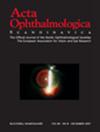Factors associated with keratoconus in Israel—A cross-sectional population-based study
Abstract
Purpose
To identify potential factors associated with keratoconus.
Methods
This cross-sectional study included data from Israel's largest healthcare provider for the years 2005–2020. Keratoconus patients and age-matched controls were identified. Demographic factors and comorbid conditions, including smoking, diabetes mellitus, asthma, myalgia, mental retardation, Down syndrome, atopic dermatitis and allergy/allergic rhinitis, were compared between the two cohorts. The independent risk factors associated with keratoconus were determined using a multivariable conditional logistic regression model.
Results
Overall, 145 508 subjects were reviewed of which 13 228 were keratoconus patients. A ten-fold group (n = 132 280) of age-matched control subjects served as controls for comparisons. In multivariable analysis, several factors were found to be significantly associated with keratoconus. Male gender (OR = 1.27, p < 0.001), Arab ethnicity (OR = 1.50, p < 0.001), diabetes (OR = 1.19, p < 0.001), asthma (OR = 1.50, p < 0.001), myalgia (OR = 1.09, p = 0.02), mental retardation (OR = 2.63, p < 0.001), atopic dermatitis (OR = 1.35, p < 0.001) and allergic rhinitis (OR = 1.21, p < 0.001) were significantly associated with keratoconus. Smoking was significantly protective of keratoconus (OR = 0.66, p < 0.001).
Conclusions
This population-based study reports male gender, Arab ethnicity, diabetes, asthma, myalgia, mental retardation/Down syndrome, atopic dermatitis and allergic rhinitis as factors associated with keratoconus while smoking demonstrates a protective effect. The results of this study could guide enhanced screening strategies and early interventions, particularly for high-risk groups.

 求助内容:
求助内容: 应助结果提醒方式:
应助结果提醒方式:


